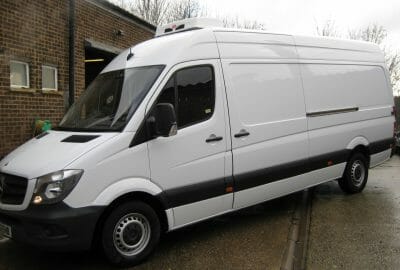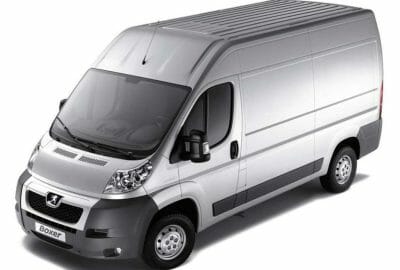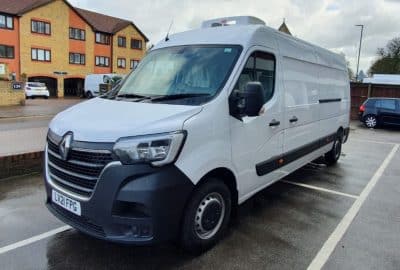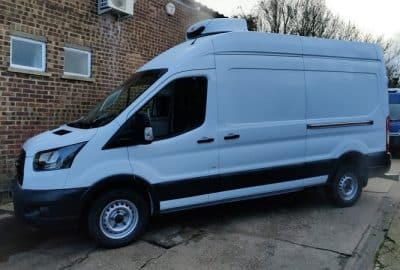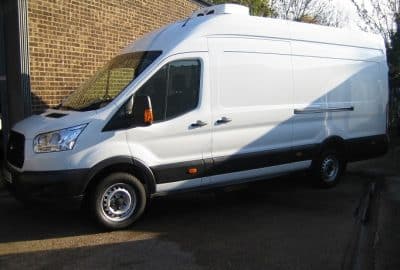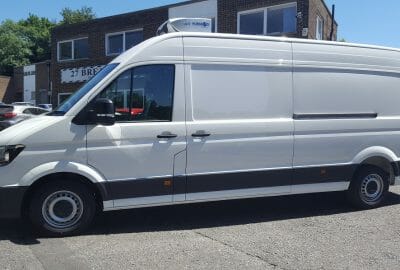A refrigerated van works like a household refrigerator but features an improved system that allows it to function optimally while it is on the move. Large freezer vans have a much thicker and higher insulation quality than regular household freezers, and also perform better as the van generates the cooling power using its powerful engine.
What are refrigerated vans used for?
Large Refrigerated vans serve the same purpose as domestic refrigerators, but are used to move products which require specific temperatures to maintain their integrity. A refrigerated van is used to:
- Supply fresh, perishable products: Freezer vans guarantee the transportation of food products from one place to another without the fear of spoilage. The cooling system can preserve goods for as long as you want, regardless of the length of the journey.
- Deliver medical supplies: Some medical supplies, including vaccines and insulin, have strict storage conditions that require cool environments. Large freezer vans are used to transport them from the manufacturer to hospitals, pharmacies or patients.
- Transport high-end art: Some items of fine art need to be transported in temperature-controlled environments to prevent damage. Refrigerated vans can do this perfectly.
- Deliver flowers: Flowers thrive in low temperatures. That is why refrigeration vehicles are used to move them from the farm to their destination.
Temperature-controlled Vehicles for Your Transportation and Logistics Needs
Supply chain
A supply chain is the network or system of people, companies, and general activities involved in getting products from the supplier to their final destination, usually the end-user. Glacier Vehicles plays an important role in the supply chain, working closely with suppliers, intermediaries, and customers to provide delivery services using Refrigerated vans.
Cold chain
The processes involved in the production, storage, and distribution of goods require a certain temperature range to protect their integrity. At Glacier Vehicles, our freezer vans are equipped to transport temperature-sensitive products. Besides providing the prescribed refrigeration requirement, they also have other features that are used to remove germs.
Distribution
We make sure we understand the specific requirements of our customers before converting or supplying them with our freezer vans. The product to be transported (including expected volumes) hugely determines the type of van you should use, as well as the compartment design, and refrigeration range, power source, and so on.
How Temperature-controlled Refrigerated vans work
Our freezer vans work like household refrigerators, fitted with components like a condenser, evaporator, insulation material, and so on. What sets them apart, however, is the sophistication of the features in our freezer vans, which makes it possible for them to achieve certain cold temperatures normal refrigeration systems cannot achieve. The refrigeration of our freezer units works by expelling heat from the cooling compartment. The insulator then prevents heat from seeping in. As the cycle of removing heat and preventing it from regaining entry continues, the compartment gets chilled quickly. The insulator in a refrigeration unit plays a key role in this process, and how well it is fitted or how thick it is has a huge impact on how cold the van’s storage space can be. The insulator is made from high-density polymer foam, containing billions of minuscule air bubbles. It is this thick foam that stops heat from penetrating the vehicle. The process of removing heat from the vehicle happens in 3 phases:
STEP 1
The condenser : The condenser starts the process of heat removal from the van. It is a network of thin pipes containing a coolant fluid, which is specially formulated to absorb heat. This fluid passes through the interlinked pipes, absorbing heat and turning it into a gas. When the gas reaches the end of the pipe, it goes into the compressor.
STEP 2
The compressor : Here, the gas is compressed at high pressure.
STEP 3
The evaporator : Once the gas pressure is high, the evaporator pumps air through it. This cools the coolant gas, returning it to its previous liquid state, which dissipates the heat. This process continues for as long as the refrigeration van’s engine is running, maintaining the temperature inside the cooling compartment.
Refrigeration vans rely on the engine to keep this process going; it is called a direct drive mechanism. There are, however, vans that use a separate generating system, but this applies mostly to vehicles that will be in one place for a long period.
Thermal engineering – refrigerated van conversion process
Refrigerated vans attain low temperatures by removing heat. This process is aided by an insulator and the mechanisms in place to expunge heat. Let’s look at the insulator and the role it plays.
Styrofoam
We use Styrofoam to keep heat out of the van. It is lightweight, providing room for higher payloads in the compartment. A payload is the amount of weight a freezer van can support. The Styrofoam also has impressive thermal characteristics that make it easier to retain cold temperatures. The density of Styrofoam used is 50mm for Refrigerated vans and 100mm for large freezer vans. The installation of the insulation material is not complete without a wet-lay or dry-lay application. We prefer the wet-lay method because it keeps the van colder and can be easily replaced if damaged.
Application of wet-lay
A fibreglass resin (GRP) is applied over the insulation and left to dry, resulting in a solid, washable coating on the insulation material. If stains or residue from previously transported goods (especially food) spills, it cannot penetrate through, and so won’t affect the integrity of the insulation. More so, the vehicle is germ-free because there are no cracks or hidden areas where spills can hide and contaminate fresh products.
Let us do your van conversion
Our engineers are experts in van conversions and can turn any van (regardless of the size or model) into a refrigerated van that fits your specifications. Freezer van conversion isn’t something you should attempt without experience, as a small miscalculation can jeopardise the entire process. That’s why we recommend Glacier Vehicles for error-free van conversions.
Temperature control
Our bespoke Refrigerated vans are fitted with temperature control units to ensure that the exact cooling condition for specific products is achieved. The temperature is monitored throughout the journey by the operator. We also offer dual temperature controls for situations where you want to transport two or more products requiring different refrigeration conditions. We achieve this by installing the following equipment according to your specifications:
Temperature-controlled fans
In cases where you need both freezer and fridge compartments in the same vehicle, we use a fan system to draw frozen air from the freezer section into the chilled area. With the aid of a thermostat, the temperature in the chilled fridge area is regulated.
Partition wall
A permanent or adjustable partition wall, or bulkhead, is fitted into the van to make two or more compartments, making it possible to have different temperatures that suit the products to be transported.
What components are used in your refrigerator van?
At Glacier Vehicles, our vans are built with refrigeration systems from GAH, a leading manufacturer of refrigeration units. With 25 years of remarkable engineering under their belts, it is easy to see why we opt for their products. The GAH systems add a lot of colour and improved functionalities to our refrigeration vehicles. These are some of the reasons they stand out in their industry and why we use their refrigeration units:
Features and benefits
Lightweight
Our large freezer vans are fitted with the SA350 refrigeration system from GAH – the lightest in its class with a total weight of 62kg. This gives room for the vehicle to carry more products for delivery.
Twin fan evaporator
The system comes with a slim, twin fan, plastic evaporator, making the job of the evaporator more efficient.
Heat/cool/freeze options
The SA350 model for large vans allows the operator to automate the temperature inside the van, based on the temperature outside the van.
Dual evaporator systems
Besides the presence of a partition wall and temperature controlled fans, a dual evaporator also plays a key role here. One evaporator serves the freezer section, and the other one is attached to the chilling compartment. Their function is to prevent cross-contamination of air from one compartment to another.
Deep freeze to -30°C
The refrigeration system is so powerful that it can lower temperatures to as low as -30°C, and it doesn’t take a long time to get to this point.
Fast and efficient defrost
In the process of cooling the van, moisture settles on the evaporator coil, which can affect productivity. The GAH unit automatically runs a defrost operation every hour to keep the coils free of frost.
Refrigerated vans Cargo Options
Our Refrigerated vans are converted with you in mind. Regardless of the goods you want to deliver, we have systems in place that can suit each product temperature requirement or loading style.
Meat Rails
To maintain the integrity of meat, it should be hung. We have a meat rail system for this. The hooks are made of stainless steel, which means there is no way your meat will fall while in transit.
Shelving
We also have the option of shelving in case you would like to categorise your products for easy sorting. Our engineers are on standby to create any design that appeals to you. The size of the vehicle does not matter; every van can be modified to your taste.
Racking system
Our racking system allows you to transport smaller goods you want to be fitted into racks. We can create as various different styles to suit your requirements.
Strip curtains
Strip curtains are useful especially if you plan to have over one delivery stop. The curtains serve as an extra layer of coverage that retains the cool air whenever the load doors are opened.
Types of Refrigerated vans
There are different Refrigerated vans in terms of size, and how much payload they can carry. This is determined by the wheelbase of the vehicle. The wheelbase is the distance between the front and rear axles of the van. There are three categorisations of wheelbase, namely:
- Long wheelbase
- Medium wheelbase
- Short wheelbase
Short wheelbase
A short wheelbase has an internal length of 1m to 1.5m and can support payloads up to 300kg to 500kg.
Medium wheelbase
This size of van can support a maximum payload of 400kg to 800kg, with an internal space of 2m to 2.5m.
Long wheelbase
This is ideal for customers who want to deliver goods in large quantities. One long wheelbase van may be all you need instead of two small or medium vans. Its compartment is anywhere from 2.9m to 4.2m and can support payloads of 800kg to 1300kg.
Small – Medium refrigerated vehicles – 2 pallet vans (2m to 2.5m internal length)
If you are looking for a refrigerated van that can carry two pallets (structures that are used to hold certain kinds of products), has an internal length between 2m to 2.5m, and can manage a payload of between 400kg and 800kg, these vehicles are ideal:
- Ford Custom
- Renault Trafic
- Vauxhall Vivaro
- Mercedes Vito
- Volkswagen Transporter
- Citroen Dispatch
- Peugeot Expert
- Fiat Scudo
- Ford Transit
At Glacier Vehicles, we don’t just deliver freezer vans, we provide support to ensure you learn all there is to know about the refrigeration system.
Medium – Large refrigerated vehicles – 3 to 4 pallet vans (2.9m to 4.2m internal length)
We also have a wide range of medium/large vans that can carry as many products as possible, giving you the option to use just one van instead of two or three small vans. Medium/large refrigeration vehicles can have payloads of between 800kg and 1300kg. Some of the larger vehicles best suited for conversion are:
- Mercedes Sprinter
- Volkswagen Crafter
- Ford Transit
- Renault Master
- Vauxhall Movano
- Nissan NV400
- Citroen Relay
- Fiat Ducato
- Peugeot Boxer
- Iveco Daily
We have over 50 Refrigerated vans on hand at any one time, but if you don’t find a specific model you need, please get in touch with us and we’ll make arrangements to get it for you.
Van features
At Glacier Vehicles, we are interested in giving value to our customers. The following features are standard when you buy from us:
Warranty
Our Refrigerated vans come with a 12-month warranty, giving you access to free repairs and servicing if your van develops a fault.
Free delivery
You will also get a free delivery service when you buy any of our refrigeration vans. We deliver to any destination in the UK, at no extra cost.
Conversions are new
Our conversions are new and built to last. We install GAH refrigeration systems of the highest quality.
Standby facility
Although most fridge vans are powered by the direct drive mechanism, we have vehicles that cater to customers who need the refrigeration system powered in stationary mode. This is ideal for people who run a catering service.
Optional Extras
We are happy to install the following additional features in your van:
- Alarm
- LED daytime running lights
- Air Conditioning
- Bluetooth
- Cruise Control
- Rear Parking Sensors
How many Refrigerated vans do you keep in stock at your dealership?
We always have a stock of no less than 50 vans of different shapes, sizes, and capacities.
How much do refrigerated vehicles cost?
The price of a refrigerated van varies but largely depends on its size. A large van would cost more, not only because of its size, but also due to having to use more insulation material and larger refrigeration systems. With decades of excellent service in the refrigerated van conversion, supply, and maintenance industry, Glacier Vehicles is the best place to get your van from. Call us today!

